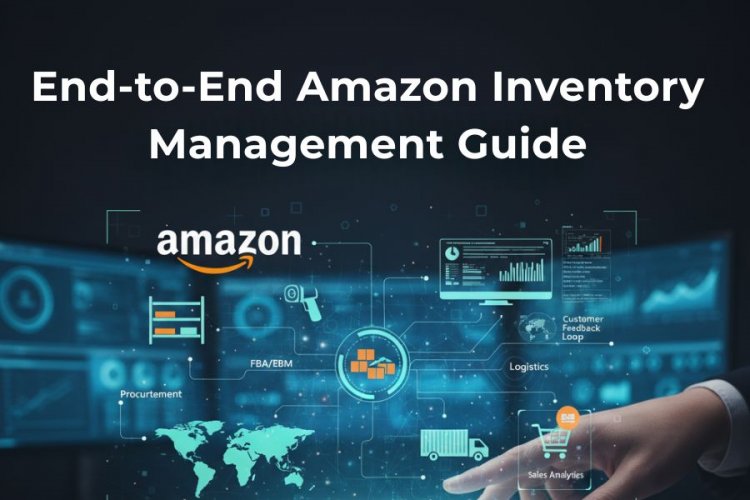Step-by-Step Amazon Inventory Management Guide 2025

In today’s competitive online marketplace, Amazon inventory management plays a crucial role in ensuring smooth operations and profitability for sellers. Whether you are a small business or a large-scale seller, managing stock efficiently helps avoid lost sales, overstocking, and unnecessary storage fees. With the rise of professional eCommerce account management services, sellers now have access to tools and expertise to streamline inventory and maximize revenue. This Step-by-Step guide will help you understand how to manage Amazon inventory effectively in 2025.
Why Amazon Inventory Management is Crucial
Amazon rewards sellers who maintain good stock health. Effective inventory management ensures:
-
Higher Buy Box percentage by keeping products in stock.
-
Lower costs by avoiding overstocking and long-term storage fees.
-
Better customer experience with timely delivery.
-
Improved sales ranking through consistent product availability.
Key Challenges in Amazon Inventory Management
Before diving into the solutions, let’s look at common challenges sellers face:
-
Stockouts leading to lost sales.
-
Excess inventory increasing storage costs.
-
Demand forecasting errors that affect profit margins.
-
SKU mismanagement across multiple product listings.
-
Manual tracking becoming complex as business grows.
This is where leveraging eCommerce management services becomes a game-changer.
Step-by-Step Amazon Inventory Management Guide
1. Demand Forecasting
The first step in inventory management is predicting demand accurately. Use Amazon reports, sales history, and seasonal data to understand customer buying patterns. Partnering with an experienced Amazon account management services compny helps automate forecasting with AI-driven insights.
2. Inventory Planning
Plan how much stock you need to order and when. Consider lead times, supplier capacity, and upcoming festive seasons like Diwali or Christmas. Strategic planning reduces both understocking and overstocking issues.
3. Multi-Channel Inventory Syncing
Many sellers list their products on multiple marketplaces (Flipkart, Myntra, Shopify, etc.). An efficient system ensures inventory is updated in real time across platforms. eCommerce services in India provide integrated solutions to manage stock across Amazon and other platforms seamlessly.
4. Replenishment Strategy
Amazon recommends sending inventory to its fulfillment centers in advance. Keep track of your Restock Limits and follow FBA guidelines. A proper replenishment strategy avoids penalties and ensures uninterrupted sales.
5. FBA vs. FBM Inventory Management
-
FBA (Fulfilled by Amazon): Amazon manages storage, packaging, and shipping.
-
FBM (Fulfilled by Merchant): You handle storage and delivery.
Evaluate which model suits your business. Many sellers opt for a hybrid approach to balance cost and efficiency. Professional eCommerce account managers can help decide the best mix.
6. Regular Inventory Audits
Conduct routine checks to avoid discrepancies between actual stock and Amazon’s records. Tools offered by eCommerce account management services provide detailed inventory health reports, reducing the risk of errors.
7. Automated Reordering
Set automated reorder alerts for fast-selling products. Automation ensures you never miss an opportunity due to stockouts. Account managers can also negotiate with suppliers for better lead times.
8. Data-Driven Decision Making
Analyze data like sell-through rates, inventory age, and IPI (Inventory Performance Index). These insights help in removing slow-moving products and focusing on high-performing SKUs.
How eCommerce Management Services Help
Managing Amazon inventory manually can be overwhelming. That’s why sellers rely on eCommerce management services. Here’s how they add value:
-
Automated tools for inventory tracking and forecasting.
-
Data-driven reports to optimize sales performance.
-
End-to-end solutions covering listing optimization, PPC campaigns, and stock management.
-
Cost savings by reducing overstock penalties and improving restock efficiency.
-
24/7 support to ensure your account runs smoothly without disruptions.
Final Thoughts
Efficient inventory management is the backbone of a successful Amazon business. By implementing proper forecasting, replenishment, and automation, you can reduce risks and maximize profitability. With the support of professional team of novel web solution, sellers can focus on growth while experts handle the complexities of inventory.
In 2025, competition on Amazon is fiercer than ever. Sellers who master inventory management will not only maintain consistent sales but also build strong customer trust.






